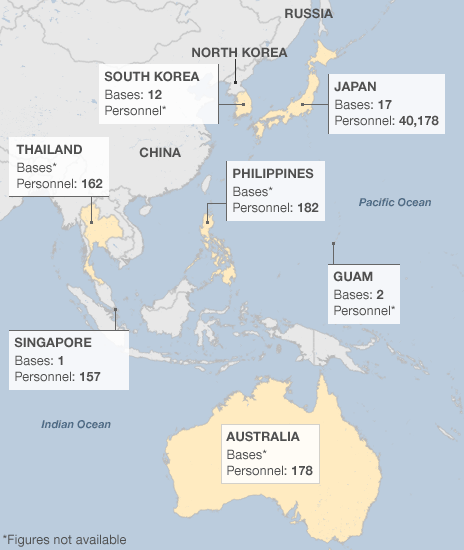The Pentagon is drawing up new plans to prepare for an air and sea war in Asia, presumably against China, in the Obama administration’s most belligerent manifestation yet of the so-called pivot to Asia-Pacific.
Fighting counterinsurgency campaigns and building up institutions over long periods of military occupations would be a thing of the past in this new theater of war. New war strategies called “Air-Sea Battle” reveal Washington’s broader goals in the region and illustrate how a war with China – which the US apparently yearns for – would play out.
“Stealthy American bombers and submarines would knock out China’s long-range surveillance radar and precision missile systems located deep inside the country,” reports the Washington Post. “The initial ‘blinding campaign’ would be followed by a larger air and naval assault.”
The Obama administration has been ramping up the pressure on China with an increasingly antagonistic foreign policy. The so-called ‘Asia pivot’ is an aggressive policy that involves surging American military presence throughout the region – in the Philippines, Japan, Australia, Guam, South Korea, Singapore, etc. – in an unprovoked scheme to contain rising Chinese economic and military influence.
“As part of the Air-Sea Battle concept,” reports Military.com, the US is refurbishing old WWII bases, looking “to disperse its air forces stationed at its handful of major bases in the western Pacific in the event of a major conflict with China.”
The idea is to have enough US bases peppered throughout the region so that China would be too surrounded to safely attack. “Doing so would make it more difficult for China to wipe out entire squadrons sitting on the ground with surprise attacks from its long range ballistic missiles.”
Chinese officials have not appreciated this unprovoked bellicosity. In May the Chinese Defense Ministry accused the Pentagon of hyping a Chinese military threat out of thin air. Others have said these Pentagon moves could start an arms race.
“If the U.S. military develops Air-Sea Battle to deal with the [People’s Liberation Army], the PLA will be forced to develop anti-Air-Sea Battle,” one officer, Col. Gaoyue Fan, said last year in a debate sponsored by the Center for Strategic and International Studies, a defense think tank.
“Some Asia analysts worry that conventional strikes aimed at China could spark a nuclear war,” according to the Washington Post. Other “critics see a dangerous tendency toward alarmism that is exaggerating the China threat to drive up defense spending.”
Such increased tensions were a predictable result of America’s needlessly aggressive postures. A recent report from the Center for Strategic International Studies predicted that next year “could see a shift in Chinese foreign policy based on the new leadership’s judgment that it must respond to a US strategy that seeks to prevent China’s reemergence as a great power.”
“Signs of a potential harsh reaction are already detectable,” the report said. “The US Asia pivot has triggered an outpouring of anti-American sentiment in China that will increase pressure on China’s incoming leadership to stand up to the United States. Nationalistic voices are calling for military countermeasures to the bolstering of America’s military posture in the region and the new US defense strategic guidelines.”



